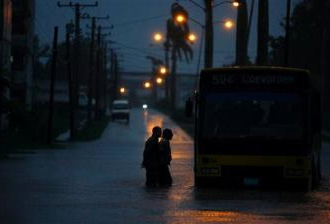
|  |  |  Americas & Beyond | November 2008 Americas & Beyond | November 2008  
Paloma Becomes Category 1 Over Storm-Weary Cuba
 Anne-Marie Garcia – Associated Press Anne-Marie Garcia – Associated Press
go to original


| | Two men wade through a flooded street toward a bus during the passing of Hurricane Paloma in Camaguey, Cuba, Saturday, Nov. 8, 2008. Hurricane Paloma slammed into southern Cuba on Saturday as authorities scrambled to move hundreds of thousands of people to safer ground and protect crops on an island still reeling from two other storms. (AP/Javier Galeano) | | |
Camaguey, Cuba — A ferocious Hurricane Paloma roared across Cuba on Sunday, downing power lines, flooding the coast and forcing hundreds of thousands of people to evacuate on an island still recovering from two other devastating storms.

Early reports of damage were limited, but Cuban state media said the late-season storm toppled a major communications tower on the southern coast, interrupted electricity and phone service, and sent sea surges of up to 700 meters along the coast.

Paloma made landfall near Santa Cruz del Sur late Saturday as an extremely dangerous Category 4 storm, but soon weakened to a Category 1 storm with winds of 85 mph (140 kph), according to the National Hurricane Center in Miami. Forecasters warned that even though the hurricane had lost its intensity, it could still produce life-threatening flash floods and mud slides.

The storm was expected to continue to lose strength even as it moved across Cuba and headed toward the central Bahamas on Monday morning. The storm was not expected to threaten the southern tip of Florida.

In the central-eastern Cuban province of Camaguey, more than 220,000 people were evacuated from low-lying areas. Another 170,000 people were moved in the eastern province of Las Tunas.

Cuba regularly relocates masses of people to higher ground ahead of tropical storms and hurricanes, preventing major losses of life.

In the city of Camaguey, 79-year-old Rosa Perez waited out the storm at a government shelter with her 83-year-old husband and about 900 others from the town of Santa Cruz del Sur.

Perez was a toddler when she watched as her mother, older sister and about 40 other relatives were swept away in a storm surge during a 1932 hurricane that killed about 3,000 people.

"We're just waiting to see what happens to our home and our beach," she said.

Fellow Santa Cruz del Sur resident Aida Perez, who is not related, watched the news with her daughters, ages 19 and 10.

"This is a really hard blow," the 44-year-old said. She was certain they would lose their home and everything in it. "What's important is that we are alive."

Outside on the nearly deserted, flooded streets, four men struggled in pouring rain to carry a refrigerator to a more secure building.

At 1 a.m. EST Sunday, Paloma was located about 25 miles (45 kilometers) southeast of Camaguey. Once packing winds of 145 mph, the storm had slowed over land and was moving northeast at about 5 mph (7 kph).

Hurricane force winds reached up to 30 miles (45 km) from the storm's center and 5 to 10 inches of rainfall was predicted in central and eastern Cuba, with isolated totals of 20 inches possible.

In an essay published in state media Saturday, former President Fidel Castro warned that Paloma could slow Cuba's recovery from hurricanes Gustav and Ike, which hit in late August and September causing about $9.4 billion in damage and destroying nearly a third of the island's crops.

The hurricane center said Paloma could bring parts of the island battering waves and a life-threatening storm surge of up to 23 feet (7 meters).

Elsewhere, Paloma knocked out power across much of Grand Cayman island, downing trees, flooding low-lying areas and ripping off roofs. But residents appeared unscathed as businesses reopened and electricity and water service were restored Saturday.

Donovan Ebanks, chairman of the Hazard Management Committee, said no injuries were reported.

"There has been minimal, if any, damage on Grand Cayman," Ebanks said.

Paloma's fierce winds ripped the roofs off some buildings on Cayman Brac, to the east.

Associated Press writers Anita Snow in Havana and Trent Jacobs in George Town, Cayman Islands, contributed to this report. |

 |
|  |



